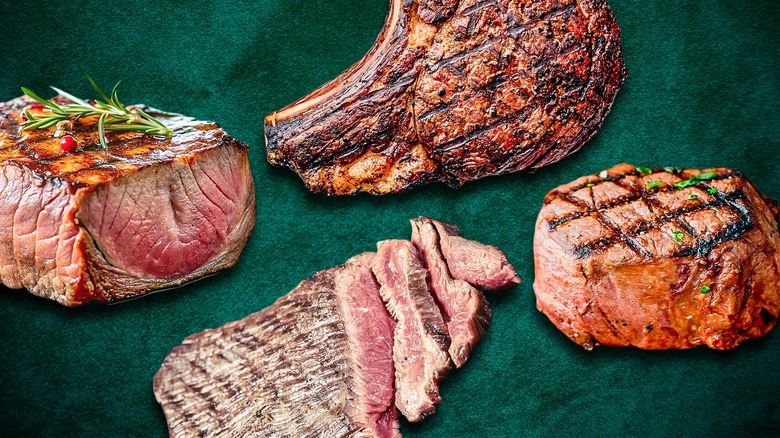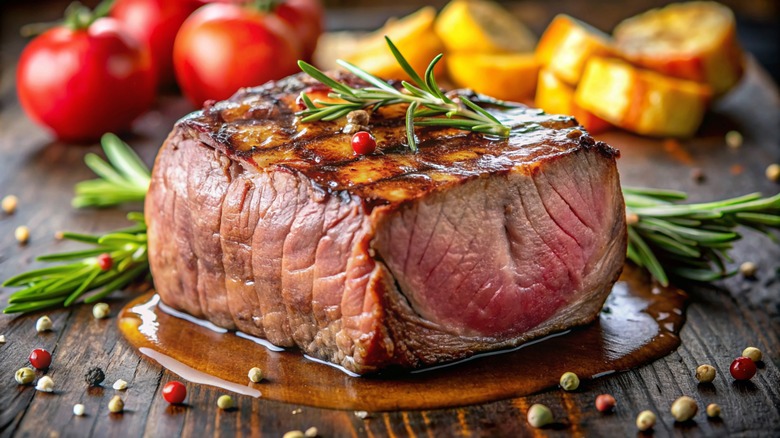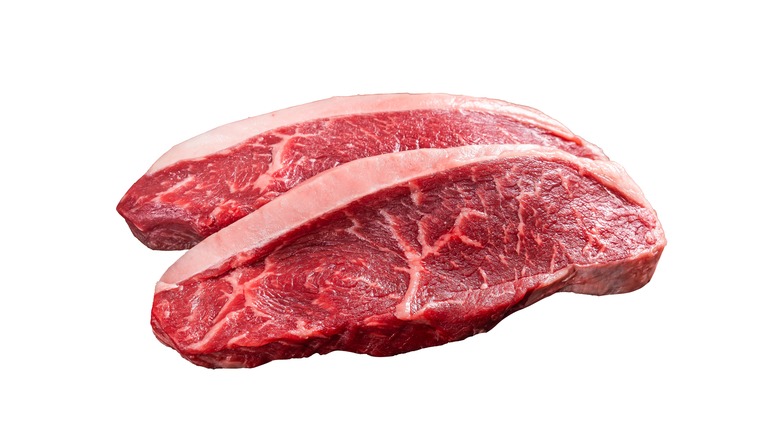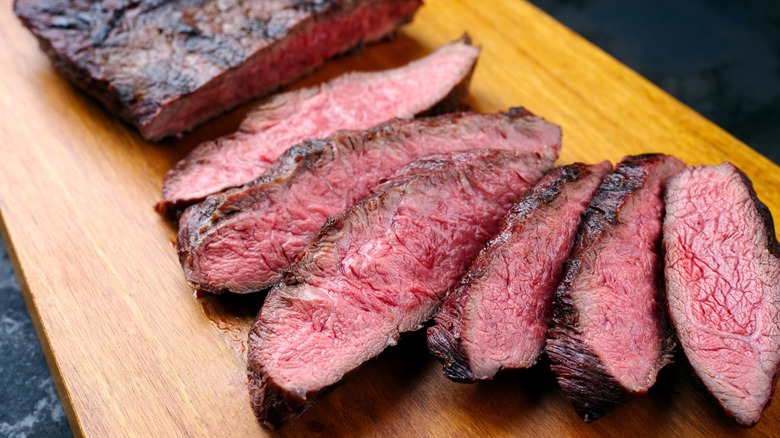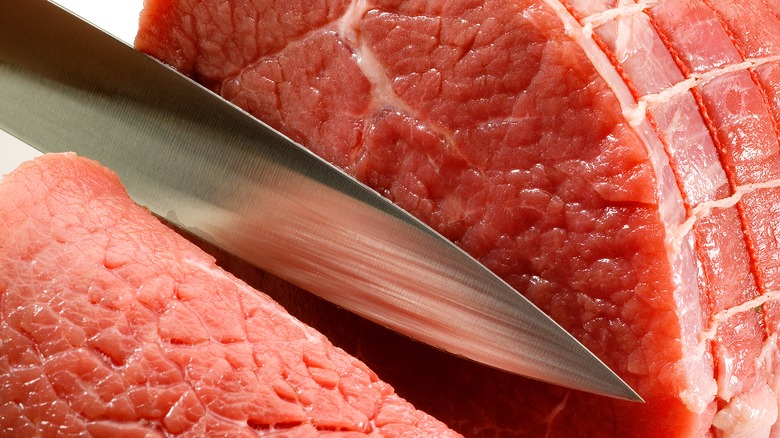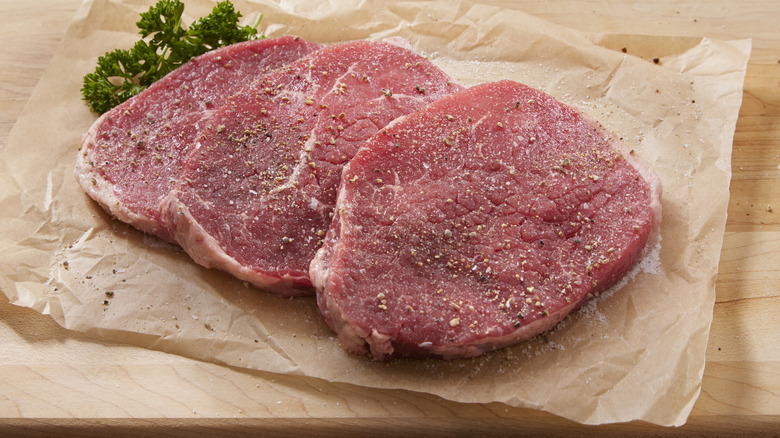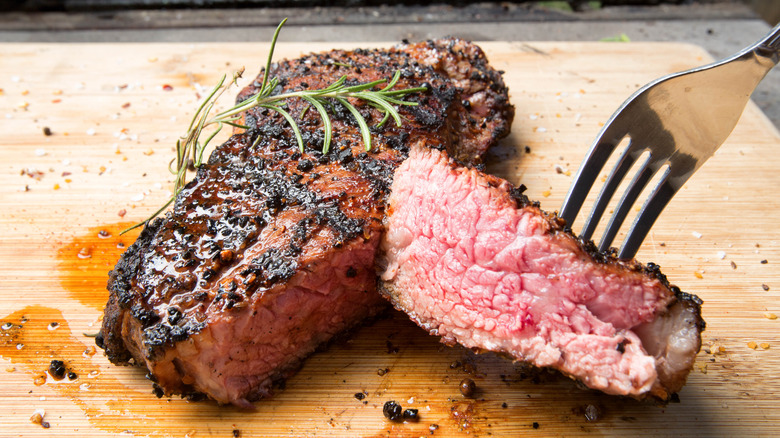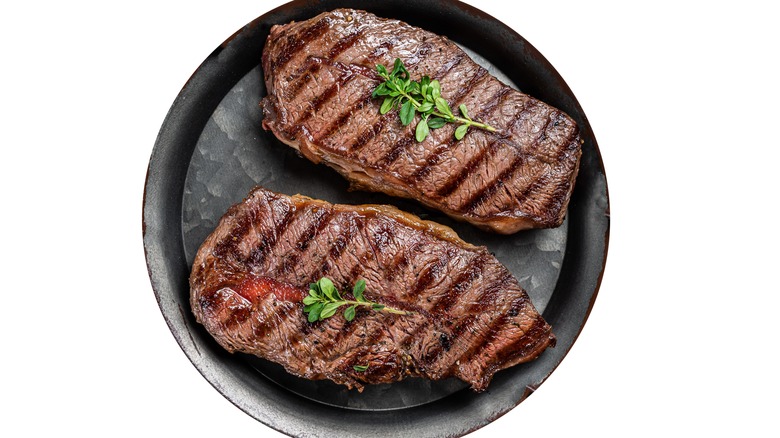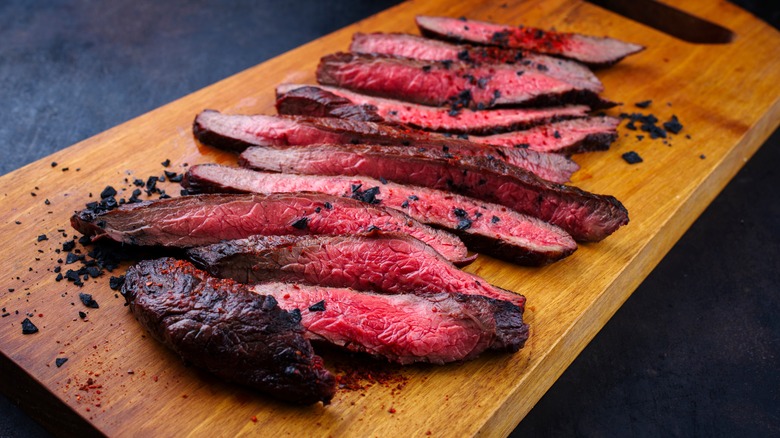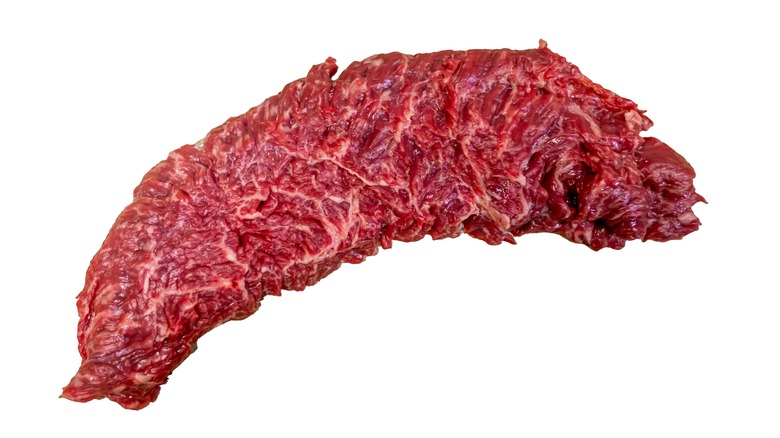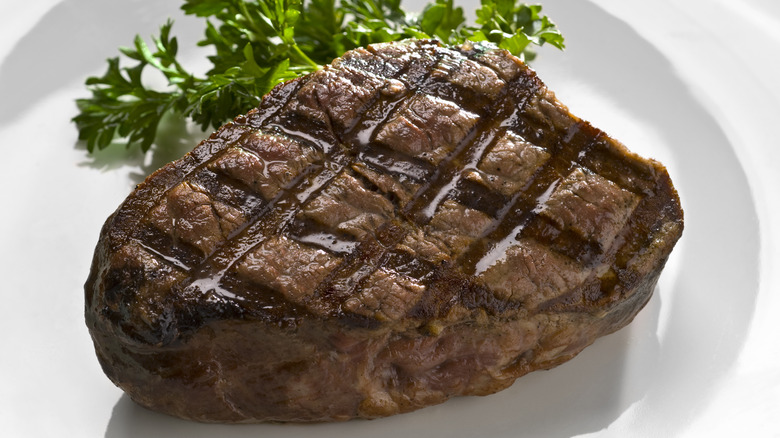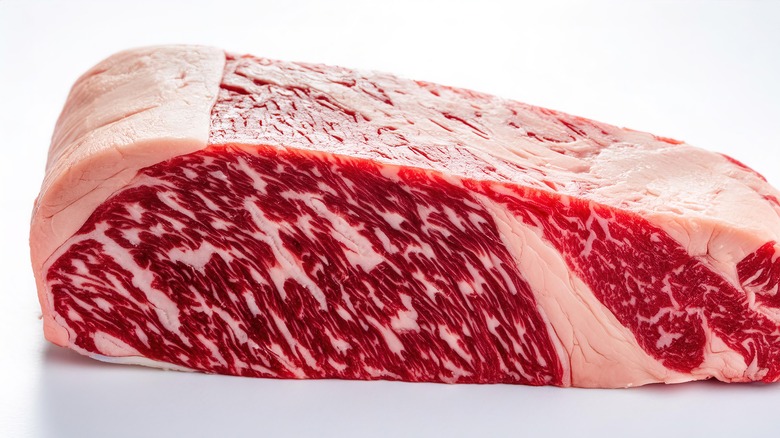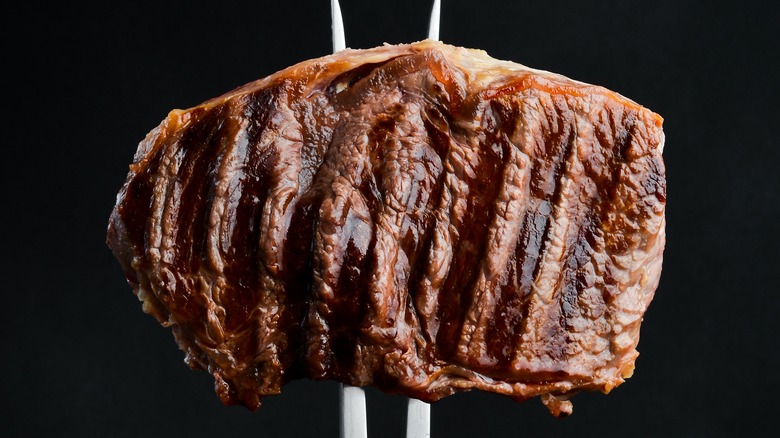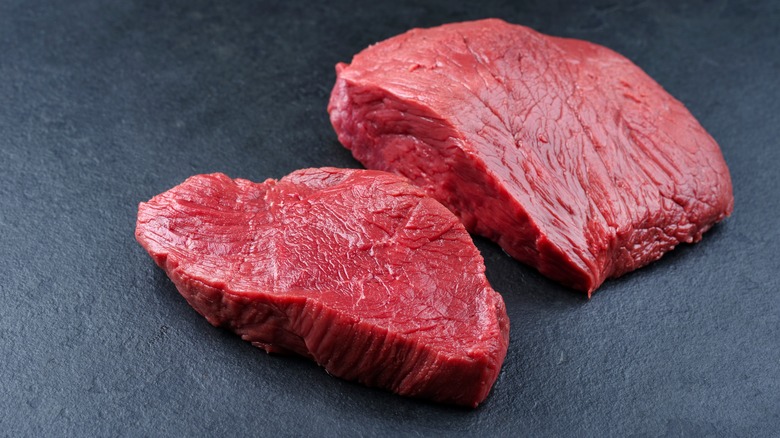The Healthiest Steaks To Order At A Steakhouse Might Surprise You
A steakhouse may seem like the last place you'd want to go if you're trying to eat healthy, but it turns out that there are loads of options that are low in fat and calories and high in nutrients — especially if you order smart. (And we don't mean you have to order fish.)
The first order of business is to look at how the steak is cooked. "When it comes to cooking steak in a healthy manner, several methods stand out for preserving the meat's nutritional value while minimizing unhealthy additives and maximizing flavor," explains Kylian Goussot, executive chef of Lafayette Steakhouse in Miami. "These methods include grilling, broiling, baking, and pan-searing without excessive butter or oil."
For Brad Johnson, CEO of Verde Farms, the leading U.S. provider of USDA certified organic, 100% grass-fed, and 100% free-range beef, chief among these options is undoubtedly grilling. "When you grill your steak, the excess fat drips away from the steak, opposed to it recirculating in a pan," he says. That said, the method used by many steakhouses — broiling — can be just as healthful, especially if the kitchen is using a broil pan. "The high heat locks in the juices and flavor while the excess fat drippings fall through the broiler pan," he says.
But choosing how your steak is cooked is just the beginning. If you want to maximize the nutritional profile of your steakhouse meal, here are the steaks our experts recommend you choose.
Beef tenderloin
When it comes to lean beef, there's simply no better option than filet mignon or beef tenderloin. This cut is one of the leanest on the cow, with 6.36 grams of fat per 3 ½-ounce portion, and its tenderness makes it a steakhouse menu staple. Its lack of fat also means that tenderloin is richer in a different macronutrient. "Your lean cuts of steak will naturally contain more protein than others," explains Johnson. "For instance, 6 ounces of filet will provide more grams of protein than 6 ounces of ribeye." In the case of tenderloin, that translates to 27.7 grams.
Goussot echoes this recommendation, noting that tenderloin is "relatively nutrient-dense, providing high levels of protein, iron, and other essential nutrients while having lower fat content compared to fattier cuts like ribeye." Indeed, tenderloin contains 3.04 milligrams of iron, 5.76 milligrams of niacin, 3.7 milligrams of zinc per 3 ½-ounce portion.
Top sirloin
Top sirloin is yet another lean cut recommended by our experts, including Matthew Kreider, executive chef at Steak 954. "For the least saturated fat and highest levels of protein, a sirloin or a round roast are the most balanced and nutrient rich," he says.
This cut hailing from the mid-back of the cow is relatively lean, with just 12.5 grams of fat and 20.5 grams of protein per 3 ½-ounce portion. According to Johnson, while "not quite as tender as a filet, sirloin provides great flavor while still being lower in fat." Top sirloin specifically offers great balance in terms of texture: Firmer than some steaks, it's by no means tough, and dry-aging it can bring out even more of its natural tenderness.
Goussot echoes this recommendation for health-conscious steakhouse-goers, as does Chef Eros (The Billionaire Chef) of Ilé, a contemporary West African concept in Hollywood, California, who notes that "this cut is relatively lean and provides a good amount of protein, B vitamins, and minerals like zinc and iron."
Sirloin flap or bavette
The sirloin flap, also known as the bavette, is a steak hailing from the lower belly of the cow. While it's heavily marbled, the marbling is fine enough that it actually boasts just 7.96 grams of fat per 3 ½-ounce portion, with 17.7 grams of protein and 1.59 milligrams of iron. Bavette gets a bit less airtime than some other steakhouse steaks, but it's long been a favorite among butchers, who love it for its rich, deep flavor. And since it's lesser-known, it tends to be less expensive than many comparable steaks.
For Kreider, it's a bit of an unsung hero for those seeking a more health-conscious menu item at a steakhouse. "I think a filet is what most people would gravitate towards when looking for a lean steak," he says. Kreider adds that while there are many cuts that are lean with a lot of flavor, bavette in particular is "a rock star that I regularly use." He compares it to the better-known flank steak, both in terms of taste and texture and for its ability to "(take) a marinade very well."
Top round steak
Top round steak is one of Goussot's top recommendations as a health-conscious, leaner cut — and that's no surprise. Top round boasts just 8.04 grams of fat per 3 ½-ounce portion, with 22.3 grams of protein, 4.02 milligrams of zinc, and 1.61 milligrams of iron.
Top round is one of several cuts hailing from the round primal, which can be found between the sirloin and the shank. This primal encompasses the rump and hind leg muscles of the cow, for steaks that are lean and inexpensive. The counterpoint is that these cuts can also be tougher, meaning that long, slow roasts or marinades bring out the best in their texture. Top round specifically is relatively tender as compared to other parts of this primal, and is most frequently cooked as London broil, which sees it marinated for a long period of time before being cooked hot and fast — usually under the broiler, thus the recipe's name. Top round is also an excellent cut for making roast beef.
Eye of round steak
Eye of round is another lean option from the round primal that Goussot recommends for its low fat content: Indeed, it may well be the leanest cut of steak out there, with just 2.68 grams of fat per 3 ½-ounce portion. "For the least saturated fat and highest levels of protein, a sirloin or a round roast are the most balanced and nutrient rich," says Kreider.
Some compare eye of round to tenderloin, though lovers of the more expensive cut would surely be disappointed to find that eye of round lacks that cut's signature tenderness. This steak hails from the bottom round subprimal, which is even tougher than top round. Its low fat content means it can prove less forgiving than fattier steaks, especially when overcooked. It's for this reason you won't often find it on a steakhouse menu, seeing as low-and-slow methods like roasting or braising do it far more favors. Still, with the right tenderizing marinade, eye of round can make for a flavorful steak that's very low in fat.
New York strip steak
New York strip is one of the most popular steakhouse cuts for a reason. Bold and beefy, this cut hails from the short loin, a fairly tender muscle that stretches from the cow's hip to its ribs. These steaks are very well-marbled, making them rich in flavor and fairly tender. As a result, they're also higher in fat than many other options on this list, with 12.5 grams of fat per 3 ½-ounce portion.
But New York strip deserves its spot as one of a steakhouse's healthiest offerings — and not just because, as the Mayo Clinic notes, it's still considered one of the leanest cuts of beef out there. Seeing as New York strip is delicious enough to enjoy without too many calorie-laden bells and whistles like loads of extra cooking fats, compound butters, and sauces, it's an excellent option for those looking for loads of flavor without all the added fat. It also boasts 21.4 grams of protein and 1.61 milligrams of iron.
Flat iron steak
Flat iron steak is a relatively new offering in the butcher's case, long relegated to ground beef due to its sinuous nature. But thanks to innovative techniques developed by researchers at the University of Nebraska and the University of Florida, this steak is now a delicious — and healthful — offering on many steakhouse menus.
Hailing from the chuck primal in the front shoulder of the cow, flat iron steak is inexpensive and relatively lean, despite boasting just enough marbling to give it lovely flavor and moisture. It's is a bit lower in fat than New York strip, with 10.7 grams of fat per 3 ½-ounce portion, and 18.8 grams of protein. It also boasts 2.32 milligrams of iron and 309 milligrams of potassium. And seeing as it's packed with flavor, you don't need to zhuzh it up to make it sing. Most agree that a quick trip over the charcoal grill is the perfect treatment to bring out all of the flavor in this succulent steak.
Flank steak
Flank steak is another leaner cut Chef Eros recommends as "both flavorful and more affordable" than many other options on a steakhouse menu. And it's also healthier than most, boasting just 9.4 grams of fat per 100-gram portion. That said, as compared to some cuts, flank steak, which hails from the hard-working flank of the cow, "can be tougher," he cautions. This is why he recommends marinating this steak before cooking it. This three-ingredient marinade is a great place to start, with heart-healthy olive oil adding a bit of moisture, and flavorful, low-calorie balsamic vinegar adding flavor and acid, which can help break down the tougher texture of this cut.
Flank steak also boasts a high mineral content, Chef Eros notes, with "a good balance of protein, iron, and zinc." This type of steak is indeed rich in minerals, with 1.83 milligrams of iron, 18.9 milligrams of magnesium, 5.56 milligrams of zinc, and 332 milligrams of potassium, and it also contains 20.1 grams of protein.
Skirt steak
Skirt steak is often confused for flank steak, seeing as both cuts are lean, long, and relatively tough. But the skirt steak hails, not from the flank, but rather the diaphragm area of the cow, giving it a less dense but more fibrous structure. As a result, it's even better for marinating than flank steak, absorbing loads of flavors relatively quickly. And since it has an intensely beefy flavor, it can take quite a bit of heat.
It's particularly tasty with marinades featuring powerful superfoods like ginger, which offer extraordinary health benefits with its antioxidant and anti-inflammatory properties. Or you could try a marinade with the superfood garlic, which research shows can also help lower blood pressure. As an added bonus, skirt steak is also slightly leaner than flank steak, with just 7.02 grams of fat per 3 ½-ounce portion, and it also contains 2.37 grams of iron.
Plain steaks without sauce or compound butter
Lower fat content was a major factor in helping our experts choose their favorite healthy steaks on steakhouse menus, but these recommendations come with one major caveat. "Leaner cuts are often basted with butter or topped with sauces to enhance their flavor and tenderness, as they have less marbling compared to fattier cuts," says Goussot. At Catch Steak, chef Michael Vignola explains, "We pair our leanest cut, the prime filet mignon, with a house-whipped black truffle butter." The director of culinary at Catch Hospitality Group says this "adds a bit of moxie to the lean cut." While certainly delicious, such accoutrements can heap on the additional calories.
But for Chef Eros, the fix is simple: "When at a steakhouse I recommend to look closely at the ingredients used in the description or ask for sauce on the side if you are worried about health concerns." Steaks can easily be cooked under the broiler or over a live fire without too much added fat, and as long as you let your server know your preference, there's no reason why that added dollop of butter or sauce can't be kept off your steak.
"Remember, this is your steak!" echoes Johnson. "If you're choosing a leaner cut to save on calories or reduce fat in your diet, never hesitate to ask how it's prepared and request a modified version. Everyone deserves to have a steak they can feel good eating."
Wagyu beef
While it might seem counterintuitive, Wagyu beef, with its high fat content, is actually a great choice from a health standpoint, according to Kreider. "It will have a better flavor profile and higher fat content," he says. "However, the fats are monounsaturated and omega-3 and 6 fatty acids like those found in salmon."
Indeed, 2016 research in the Korean Journal of Food Science of Animal Resources showed that highly marbled Wagyu and Hanwoo beef — the latter of which is a similar Korean style of highly-marbled beef — boasts a higher composition of monounsaturated fatty acid, which can lower LDL cholesterol levels and raise HDL cholesterol levels. The study points out that high oleic acid in Wagyu and Hanwoo beef might actually help to combat cardiovascular disease.
And that's not the only reason Wagyu beef is a great option from a health standpoint, according to Vignola: "Wagyu yes is intensely rich in marbling, however you only need a little to satiate that craving." Most often, portions of Wagyu at steakhouses are far smaller than those served of other steaks, allowing you to savor each morsel without a risk of overeating.
Grass-fed beef
No matter which cut you choose, grass-fed beef is always going to be the best option on any steakhouse menu from a health perspective. According to Goussot, grass-fed beef is "generally leaner and contains more omega-3 fatty acids and antioxidants."
"When it comes to the different types of steaks, USDA Organic, 100% grass-fed steaks are the healthiest and most beneficial to our bodies," echoes Johnson, noting that this is the case not just for our own health but indeed for that of the planet. "To take it a step further, when you purchase steaks where cattle are raised humanely and farmed on regenerative land, it provides the most benefit to us, the animals, and our planet. USDA Organic beef means that we are not consuming any fertilizers or pesticides that were used to treat the grass the cattle were fed. And the 100% grass-fed diet creates a steak that is leaner, lower in calories, contains more omega-3s plus higher levels of essential vitamins, minerals, and antioxidants. Regeneratively raised cattle is not only a humane way to treat our cattle, but it also improves our climate and landscapes, and provides a diverse range of grasses for the cattle to consume."
Bison or buffalo steak
If you're willing to think outside of the box on your next steakhouse visit, consider opting not to eat beef steak at all. "Bison and buffalo are healthier than beef," according to Vignola, who notes that bison is richer in certain micronutrients than beef. Bison tastes fairly similar to beef, albeit with a little bit of a sweeter flavor and less distinct meatiness. Its iron levels can give it a nice simple flavor, and it usually tastes less greasy or fatty than beef.
Bison is indeed richer in certain micronutrients, such as selenium, of which it boasts 35.4 micrograms per 3 ½-ounce portion as compared to 29.8 micrograms in the same amount of beef. Bison is also a bit richer in iron, with 3.41 milligrams in a 3 ½-ounce serving size, compared to 2.26 milligrams in the same amount of beef. Bison is also about 25% lower in calories than beef, due to its lower fat content. But these discrepancies aren't necessarily innate to bison. In reality, most experts claim it stems from the way in which beef and bison are farmed. There is a far higher likelihood that bison will be grass-fed rather than grain-fed, contributing to these and other health benefits, such as its richness in anti-inflammatory conjugated linoleic acid (CLA). For these reasons, bison meat might be a more heart-healthy option than beef.
